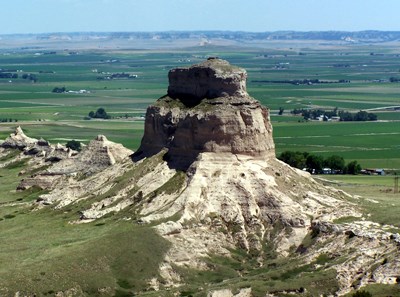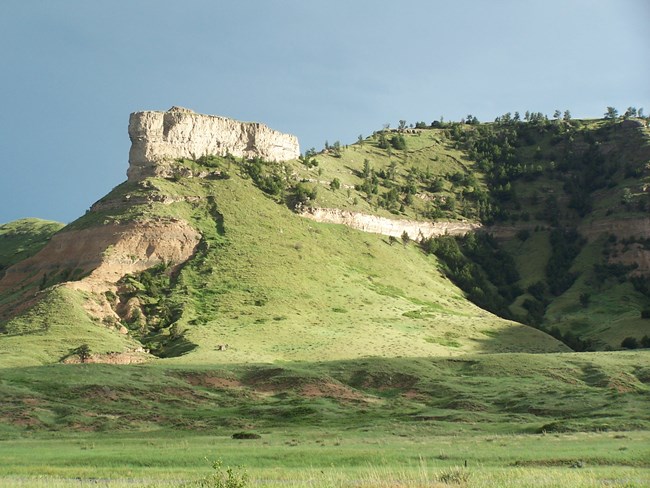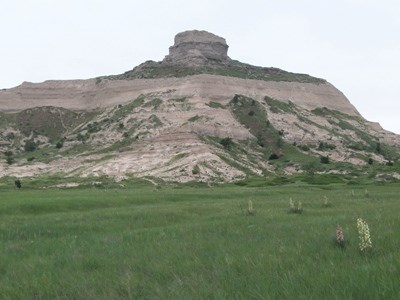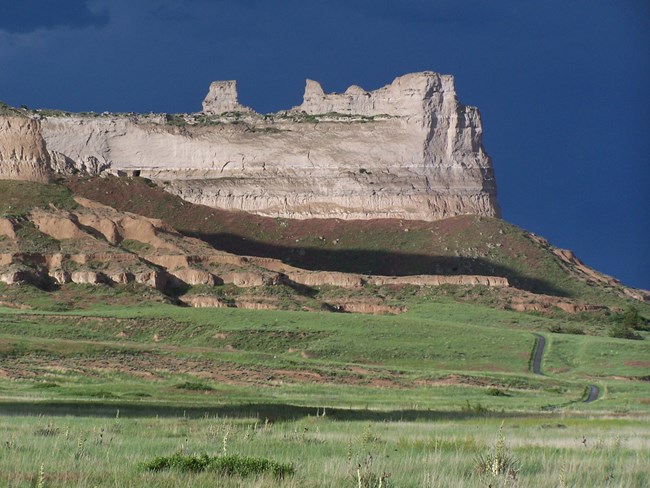
NPS Scotts BluffScotts Bluff, historically referred to as Scotts Bluffs, refers to the range of hills which parallels the river, and is the largest isolated land mass in Nebraska. Although Scotts Bluff was named for Hiram Scott, an employee of the American Fur Company who died here in 1828, it was referred to by many names throughout history such as: Capital Hills, Convent Rock, Gibraltar, Scott’s Rock or Scotts Bluff Mountain to name a few.

NPS Dome RockDome Rock reaches to 4,396 feet (1,339.90 meters) above sea level. It's summit towers 180 feet (50 meters) above the valley floor. According to early diaries, Dome Rock reminded pioneers of the capitol dome, hence the name. It appears from a distance more like a grain elevator. The name “Dome Rock” was officially adopted by the U.S.G.S. on June 11, 1941, after being submitted by the National Park Service on April 3rd of that same year. Dome Rock has been referred to by many names down through history, such as a: tower, spire, lighthouse, castle, church and cathedral. At one time, Charles Gering owned half of Dome Rock and the National Park Service owned the other half. The Oregon Trail Museum Association (OTMA) purchased Gering’s half and later sold it to the National Park Service.
NPS Crown RockThis promontory rises 4,557 feet (1,388.97 meters) above sea level. The top of Crown Rock sits 333 feet (101 meters) above the valley floor. Early pioneer diary accounts mention that men would climb up here and roll rocks down on wolves in the trees below to see them run. The crown is the knob of rock on top of the summit. 
NPS Sentinel RockThe squat column sitting on the end of South Bluff rises 4,390 feet (1,338 meters) above sea level. The top of Sentinel Rock sits 166 feet (51 meters) above the valley floor. Sentinel Rock forms the south abutment of Mitchell Pass. The rock is named for the comparatively small block which stands like a watchtower against the sky that formed as the capping layers of strata eroded away. Sentinel Rock was originally referred to as Sentinel Hill. There is a tradition that this pinnacle, as well as that portion of Scotts Bluff which adjoins Mitchell Pass on the north, was used as an observation tower. 
NPS/Eric Grunwald Eagle RockLooking like a halved dome, Eagle Rock rises 4,482 feet (1,366.11 meters) above sea level. The summit of Eagle Rock lies 258 feet (79 meters) above the valley floor. In 1853, Mariett Foster Cummings stated, “There is a pass through that is guarded on one side by Sugar Loaf Rock [Eagle Rock], on the other by one that resembles a square house with an observatory [Sentinel Rock]. There is one (nearest the river) that is certainly the most magnificent thing I ever saw.” Eagle Rock forms the north side of Mitchell Pass through which thousands of emigrants drove their covered wagons single file and Pony Express riders galloped to deliver mail. 
NPS Saddle RockThis narrow buttress of rock rises 4,659 feet (1,366.11 meters) above sea level, 780 feet (238 meters) above the North Platte River, and 435 feet (133 meters) above the valley floor. Saddle Rock was named for the indention between two thin spires on the bluff’s edge. Saddle Rock has also been referred to as “Motorcycle Rock”, “Grandpa’s Toes”, and “Steamboat Rock” among other names. The Saddle Rock Trail runs from the Visitor Center to the summit of Scotts Bluff and has its own tunnel to walk through. |
Last updated: May 18, 2023
